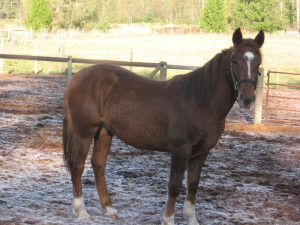You cannot ask a horse to do liberty horse training and be fair to him without good management. A horse has a unique physiology and therefore needs management like no other domestic animal. Many problems and health crises can be prevented with proper daily regimes. All my life, I have seen great horses get sick or injured so if only one horse’s life can be spared because of this website, I will be happy (and please let us know.)
Digestion: Horses cannot vomit if they eat something their bodies would rather they didn’t and this has profound effects regarding the health of their intestines. They need to eat ruffage almost constantly in the ideal world. We fill nibble nets which slows down the amount of hay they can eat. I have a very low quality local hay we feed as a base, especially for the horses with a low metabolism, smaller, thicker and sturdier breeds. My thoroughbred needs higher quality hay but he gets it constantly. Colic is a disease caused by impaction, gas or torsion, sometimes needing surgery but always needing medical attention. Most colics are preventable. Keeping the hay moistened is how horses are managed in England. I make sure we soak all grain and pellets for a full eight hours before feeding. The more food can be soaked (not so long bacteria will grow) and lower quality food offered, the more the horse will thrive.
Water: To prevent colic, horses need clean water at all times. Automatic waterers are not good for horses because you cannot measure water consumption. If there is fecal matter or rodents floating in a horse’s water, he would rather colic than drink it. If you cannot find the time to clean his buckets or trough, then perhaps it would be best to be kind to your horse and find another home for him.
If raised with a herd or in semi-natural settings, horses are normally very clean animals (thoroughbreds like Charlie excluded.) Their natural instinct is to keep food and fecal matter separate, for instance. So their water source should be clean enough for you to drink. In the summer we scrub out our smaller (50 gallon) troughs a few times a week and in the winter, we have heaters at the bottom of the trough with the electric cord on the opposite side of the fence. Increasingly, finding clean water sources for humans is getting harder due to chemical contamination (think of the water when you spray herbicides) and other causes. We are on a water association with a well several hundred feet underground, but we are lucky. Most of Bellingham’s water source is Lake Whatcom, a lake used for motor boats and chemical use is rampant around the lake. Horses drink in excess of 15 gallons a day depending on ambient temperature and exercise. The more water consumption, the less tendency towards impaction colic.
Endocrine issues: Horses are much like people in America these days. Their calorie intake is too great and their exercise is too little. Cushings, insulin-resistance, diabetes and laminitis can all be related to metabolic imbalances which is normally a management issue. Working a horse every day even on a lunge line for 15 minutes can be very helpful. Not feeding alfalfa hay or cubes is normally a good idea. Recognizing when the horse’s coat is long and not shedding correctly or when his or her neck is getting roachy (thick with fat) is important.
Excess Confinement: Generally horses in a stall more than twelve hours a day run the risk of developing sub-clinical ulcers from low-grade chronic stress. I have stalls for night-time use and they can be wonderful. In the winter, all horses lay down to sleep in their stalls. Laying down helps preserve the health of good legs; even though horses can sleep standing up, it is not preferred. In the summer, the horses love their stalls to get away from biting insects and in the cool of the barn. In order to prevent a horse getting cast (stuck while rolling) in his stall, take steps to prevent colic, give him lots of access to daytime rolling so he can scratch his back and bed the stalls with a bank of bedding in the back and corners. Larger stalls can also prevent a horse from casting; ours are 12×14. Generally horses are better off without stalls. Their entire musculoskeletal system can break down with too much time in stalls or small paddocks. They develop more back problems, leg problems, digestive problems (from GI ulcers) and endocrine problems.
Footing: Horses thrive in the plains, with great soil drainage so here in the Pacific Northwest, we built a large 140 by 80 paddock for each horse with feet of gravel, sand, road fabric and hog fuel for soft padded but draining footing. It is very important that horses do not stand in mud all day long and that they can run, canter and play at any point during the day. Managing horse’s footing around here is very difficult but essential to put the time and money into doing it right.

